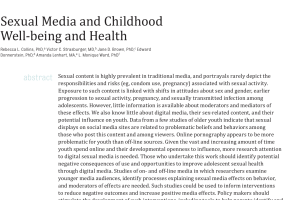Abstract
Sexual content is highly prevalent in traditional media, and portrayals rarely depict the responsibilities and risks (eg, condom use, pregnancy) associated with sexual activity. Exposure to such content is linked with shifts in attitudes about sex and gender, earlier progression to sexual activity, pregnancy, and sexually transmitted infection among adolescents. However, little information is available about moderators and mediators of these effects. We also know little about digital media, their sex-related content, and their potential influence on youth. Data from a few studies of older youth indicate that sexual displays on social media sites are related to problematic beliefs and behaviors among those who post this content and among viewers. Online pornography appears to be more problematic for youth than off-line sources. Given the vast and increasing amount of time youth spend online and their developmental openness to influence, more research attention to digital sexual media is needed. Those who undertake this work should identify potential negative consequences of use and opportunities to improve adolescent sexual health through digital media. Studies of on- and off-line media in which researchers examine younger media audiences, identify processes explaining sexual media effects on behavior, and moderators of effects are needed. Such studies could be used to inform interventions to reduce negative outcomes and increase positive media effects. Policy makers should stimulate the development of such interventions, including tools to help parents identify and manage negative media influences on their children’s sexual well-being and development and dissemination of innovative media literacy programs related to sexual health.
This article was published in a special 2017 supplement of Pediatrics, a journal of the American Academy of Pediatrics. The supplement, “Children, Adolescents and Screens: What We Know and What We Need To Learn,” was produced by Children and Screens and includes the contributions of more than 130 interdisciplinary authors across 22 papers. See a complete list of articles included in the supplement.
